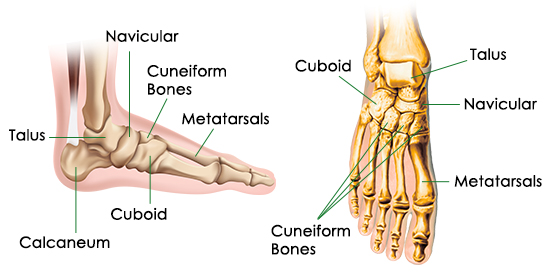Considering the overall usage of feet humans make in day-to-day life, it is very important for us to know some details about foot bones and their relevance. Continue reading...

The foot is a part of the leg or limb of human beings, just below the ankle joint, which helps in locomotive functions such as walking, running or jumping. At the same time, it is also responsible for bearing the entire weight of the body and supporting it; and that makes it all the more important. There exist as many as 206 bones in an adult human body. Excluding the 2 sesamoid bones located underneath the first metatarsal head, the foot consists of 26 bones which are categorized into 3 groups - the Tarsus (tarsal bones), Metatarsus (metatarsal bones) and the Phalanges.
Tarsal Bones
Tarsus or Tetrapods is a cluster of bones located between Tibia, Fibula and the Metatarsus. They are all-together 7 in number namely Calcaneus, Talus, Navicular, Medial Cuneiform, Intermediate Cuneiform, Lateral Cuneiform and Cuboid.
- Calcaneus is the heel bone in the human foot which is located between the Talus and Cuboid.
- Talus is the ankle bone that articulates with the tibia at the top, fibula at the sides and the Calcaneus below. It is the 2nd largest of the tarsal bones and has retrograde blood supply.
- Navicular is a boat shaped bone located in the mid portion of the foot. It articulates with Talus and the three cuneiform bones.
- Medial Cuneiform is the largest of the cuneiform bones situated in the mid-portion of the foot. It articulates with the 1st metatarsal and the Navicular.
- The Intermediate Cuneiform is the wedge shaped bone articulating with the 2nd Metatarsal and the Navicular. It is located in the middle of the three cuneiform bones.
- Lateral Cuneiform occupies the front row of the tarsal bones. It is also called the 3rd Cuneiform or the external cuneiform. It articulates with 2nd Metatarsal and the Navicular.
- Cuboid is the last of the 7 tarsal bones, it articulates with 4th and 5th metatarsals as well as Calcaneus and Navicular.
 Metatarsal Bones
Metatarsal Bones
Metatarsus is made up of 5 long bones which form the middle part of the foot. The base of each of the metatarsal bone articulates with some of the tarsal bones, while the head articulates with the first row of Phalanges.
- The bone in the foot just behind the big toe is the 1st metatarsal bone. It is the shortest but the thickest among the group of metatarsal bones.
- The 2nd Metatarsal bone is the longest of the metatarsal bones, which is held firmly between the 1st and 3rd cuneiform bones. Injury to this bone is a common phenomena among football players. Football superstars such as David Beckham, Michael Owen, Gary Neville, etc have experienced injuries to their 2nd Metatarsal bones in recent times.
- The 3rd Metatarsal bone articulates the 3rd Cuneiform along with the 2nd and 4th Metatarsal bones.
- The 4th Metatarsal bone, is a bit smaller than the 3rd metatarsal bone, and articulates with the Cuboid and the 3rd cuneiform along with the 3rd and 5th metatarsal bones.
- The 5th Metatarsal bone articulates with the Cuboid and the 4th metatarsal bone. Stress fracture, which happens to be a common injury among athletes, is associated with 5th metatarsal bone. The Jones fracture is a yet another common injury associated with 5th metatarsal.
Phalanges
Phalanges are the bones of the toe. There are a total of 14 phalanges in a human foot. Each toe, except the big toe or Hallux, has 3 phalanges; the Proximal phalanx, the Middle phalanx and the Distal phalanx. The Hallux or big toe has only 2 phalanges; the proximal phalanx and the distal phalanx. The phalanges of the first row articulate with the metatarsal bones behind them.
- The Proximal phalanx is located at the start of the toe. It articulates with the metatarsal bone and middle phalanx.
- The Middle phalanx is located below the distal phalanx in 2nd, 3rd, 4th and 5th toes. The big toe doesn't have any middle phalanx.
- The Distal phalanx is found at the end of each toe. These bones form the tip of the fingertoes.
These 26 bones form an important part of the anatomy of human foot, and any injury to them can lead to serious implications in our day-to-day life. Other than these bones, there also exist two sesamoid bones, embedded within the tendon of flexor hallucis brevis, in the first metatarsal bone which connect it to the hallux (big toe).


 The foot is a part of the leg or limb of human beings, just below the ankle joint, which helps in locomotive functions such as walking, running or jumping. At the same time, it is also responsible for bearing the entire weight of the body and supporting it; and that makes it all the more important. There exist as many as 206 bones in an adult human body. Excluding the 2 sesamoid bones located underneath the first metatarsal head, the foot consists of 26 bones which are categorized into 3 groups - the Tarsus (tarsal bones), Metatarsus (metatarsal bones) and the Phalanges.
The foot is a part of the leg or limb of human beings, just below the ankle joint, which helps in locomotive functions such as walking, running or jumping. At the same time, it is also responsible for bearing the entire weight of the body and supporting it; and that makes it all the more important. There exist as many as 206 bones in an adult human body. Excluding the 2 sesamoid bones located underneath the first metatarsal head, the foot consists of 26 bones which are categorized into 3 groups - the Tarsus (tarsal bones), Metatarsus (metatarsal bones) and the Phalanges. Metatarsal Bones
Metatarsal Bones